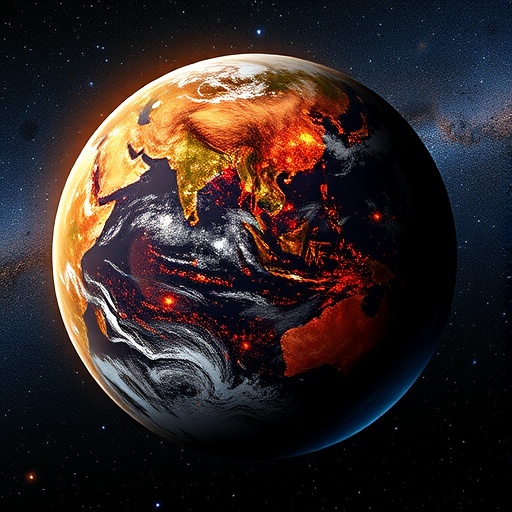A groundbreaking study led by esteemed researchers from the University of Sydney and the University of Adelaide has unveiled how the fragmentation of an ancient supercontinent around 1.5 billion years ago profoundly reshaped Earth’s surface environment. This tectonic transformation set the stage for the emergence of complex life forms by altering the planet’s carbon cycle and ocean chemistry, providing fresh perspectives on how Earth’s deep geological processes influenced the biological evolution of our planet.
Central to this research is a tectonic model that chronicles 1.8 billion years of Earth’s history, reconstructing ancient plate motions and continental configurations with extraordinary detail. The investigation revisits a once-dismissed interval in Earth’s history, often called the “Boring Billion,” a period long thought to be marked by geological and biological stagnation. Contrary to this notion, the study reveals a dynamic Earth where plate tectonics drove significant environmental changes critical to supporting oxygen-rich oceans and the rise of eukaryotic life.
Eukaryotes—organisms with complex cells containing a nucleus and organelles—represent a pivotal biological innovation, encompassing all plants, animals, and fungi. The study posits that tectonic events triggered mechanisms reducing volcanic carbon dioxide emissions while simultaneously expanding shallow marine habitats. This facilitated an ecological environment highly conducive to the evolution and diversification of these complex life forms, fundamentally altering our understanding of Earth’s habitability deep through time.
Between approximately 1.8 and 0.8 billion years ago, Earth witnessed two colossal episodes of continental assembly and subsequent disintegration, first with the supercontinent Nuna, and later Rodinia. By integrating plate tectonic reconstructions with advanced computational simulations, the team explored how shifting plate boundaries and changing continental margins influenced carbon cycling between the Earth’s mantle, hydrosphere, and atmosphere across this vast geological timespan.
Their models discerned that around 1.46 billion years ago, the disintegration of Nuna led to a striking expansion of shallow continental shelves, effectively more than doubling their total length to about 130,000 kilometers. These extended continental margins likely developed into stable, oxygenated shallow seas—archipelagoes of ecological sanctuary—where early complex multicellular life could take root within nutrient-rich and temperate marine habitats.
Simultaneously, the researchers identified a substantial decline in volcanic carbon dioxide outgassing. This reduction occurred alongside increased carbon sequestration within the oceanic crust, facilitated by an enlargement of mid-ocean ridge flanks. Here, seawater permeates newly formed volcanic crust, undergoes hydrothermal alteration, and precipitates carbonates such as limestone, thereby locking away carbon dioxide and mitigating atmospheric greenhouse gases.
This interplay between decreased volcanic emissions and enhanced geological carbon storage generated a climate cooling effect and chemically transformed the oceans. The shift towards lower atmospheric CO2 and higher oxygen levels created conditions that favored the proliferation of complex life, particularly oxygen-dependent eukaryotes. These findings signify a profound geochemical feedback loop linking tectonic activity with biological milestones.
Furthermore, the research connects these tectonically-induced environmental changes directly to the fossil record, which shows the appearance of the earliest eukaryotic fossils approximately 1.05 billion years ago—a period coinciding with the dispersal of continents and the expansion of shallow seas. This synchrony strengthens the hypothesis that tectonic fragmentation was instrumental in promoting biological innovation.
These ancient shallow marine environments act as “tectonically stable incubators,” providing geochemically steady habitats with increased availability of oxygen and essential nutrients. Such conditions likely catalyzed biological complexity, enabling eukaryotes to evolve and diversify. The study underscores how geological stability over millions of years is crucial for sustaining early life’s evolutionary experiments.
The implications of this investigation extend beyond paleobiology, providing a unified conceptual framework linking deep-Earth dynamics, climate modulation, ocean chemistry, and life’s evolutionary trajectory. It presents a holistic view of Earth system science, illustrating how plate tectonics directly influenced the planet’s habitability over geological timescales.
A novel feature of the study is its quantitative integration of geological and biological data, employing cutting-edge computational modeling techniques. These simulations combine tectonic reconstructions with thermodynamic models of carbon fluxes, encompassing volcanic degassing, subduction-driven carbon cycling, and marine geochemistry, offering an unprecedented window into Earth’s co-evolution of lithosphere, atmosphere, and biosphere.
By bridging gaps between disciplines, this research redefines our understanding of the so-called “Boring Billion,” revealing it as a centuries-long chapter of subtle but consequential transformations underpinning the evolution of complex life. It challenges prior assumptions and accentuates the importance of continuous geological activity in shaping global environmental conditions.
Ultimately, this work reframes Earth’s deep-time history, portraying it as an intricately linked chain of geological processes orchestrating the rise of biological complexity. The fragmentation of Nuna emerges as a crucial geological catalyst that reshaped Earth’s carbon cycle, marine habitats, and paved the way for the advent of the eukaryotic domain—a testament to the profound interplay between Earth’s interior and surface life.
Subject of Research: Not applicable
Article Title: Mid-proterozoic expansion of passive margins and reduction in volcanic outgassing supported marine oxygenation and eukraryogenisis’
News Publication Date: 27-Oct-2025
Web References:
- Research article link
- EarthByte Group
- University of Sydney Plate Tectonics model
- Computational models repository
References:
- Müller, R. D. et al. ‘Mid-proterozoic expansion of passive margins and reduction in volcanic outgassing supported marine oxygenation and eukraryogenisis.’ Earth and Planetary Science Letters, 2025. DOI: 10.1016/j.epsl.2025.119683.
Image Credits: Dietmar Müller/EarthByte Group/The University of Sydney
Keywords: plate tectonics, supercontinent breakup, Proterozoic, carbon cycle, volcanic outgassing, marine oxygenation, eukaryotes, early life evolution, continental shelves, mid-ocean ridges, geochemical cycles, deep Earth processes




